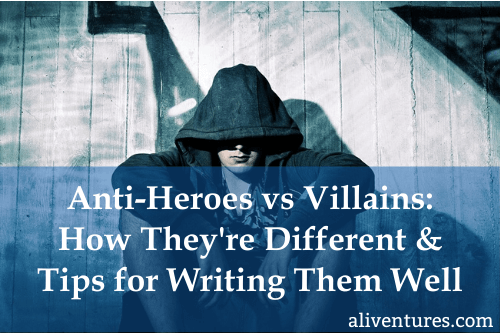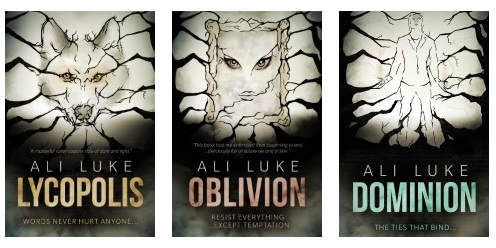Anti-Heroes and Villains: How They’re Different & Tips for Writing Them Well

This post was originally published in December 2016 and updated in June 2020.
Most stories, these days, don’t have flawless heroes and evil cackling villains. Readers – and writers! – enjoy more complex characters.
At what stage, though, does a dark hero (aka “anti-hero”) turn into a villain?
The line between them can be blurry, and is as much about story role as it is about morality.
Some characters can be tricky to categorise, and may potentially move from one role to another – especially in a series of connected works. (In the Marvel movies, for instance, Loki is arguably an anti-hero in Thor and a villain in Avengers.)
In writing and literary circles, you’ll often hear “protagonist” and “antagonist” being used instead of “hero” and “villain” because these are a bit more emotionally neutral and describe a function within the story rather than a type of character … and this is the framework we’re going to use.
Let’s take a look at anti-heroes vs villains, and how to write them well:
Anti-Heroes: Deeply Flawed Protagonists
The classic hero – think Captain America, in the Marvel films – tends to be brave, good looking, morally upright, strong (if male) … and so on.
Most regular heroes do have flaws, but these don’t make up the bulk of their character, and they tend to be things they overcome during the story.
So what’s the definition of an anti-hero?
Anti-heroes subvert expectations. They’re – just about – on the good side of things, but they may not be pleasant people, and they might well resort to some shady tactics to get things done.
They’re a good way to avoid the common writing problem of creating “flat” or two-dimensional characters: ones that don’t have much complexity.
They may change a bit during the course of the novel. However, they’re unlikely to become a completely straightforward hero, because that would make their character virtually unrecognisable.
Some of my favourite examples of anti-heroes are:
- Elizabeth Bennett in Jane Austen’s Pride and Prejudice – she’s a fairly mild example of an anti-hero. However, she’s not a conventionally pretty, tame 19th century heroine; she’s snarky, has her faults, and is too quick to believe Wickham and hate Darcy.
- Gerald Tarrant in Celia Friedman’s Black Sun Rising trilogy – though he could, at least early on, also be categorised as a villain. He’s at the very dark end of the anti-hero scale.
- Jack Sparrow in Pirates of the Caribbean – he’s a pirate, and pirates are pretty much anti-heroes by definition. You also get villainous ones with even lower moral standard.
- Dexter in Dexter – a serial killer. But he is very much the protagonist and our main viewpoint character – we don’t get anyone else’s voiceovers, for instance. He follows a moral code, only killing particularly nasty characters.
- Sherlock Holmes in the TV show Sherlock (and to an extent, in the original novels). He describes himself as a “high-functioning sociopath” and can be downright rude to other people.
- Both Elsa and Kristoff in Frozen. Elsa was originally intended to be the villain, though Disney changed the plot (and in doing so, made their film a runaway success). Kristoff is the slightly snarky, aloof type of anti-hero.
In stories with a romance-based plot (ending in a marriage/relationship), there’s often a heroine who’s the main viewpoint character but also a male lead who we call the “hero”. These heroes, too, can be anti-heroes:
- Will in Emma Davies’ Letting In Light – who is grumpy and aloof, and at times rather mood-swingy, towards the heroine. Part-way through, we learn why and he becomes a more sympathetic character.
- Darcy in Pride and Prejudice – he’s taciturn and refuses to dance, even when there are ladies in need of a dance partner (apparently a grave social sin). The archetype for the brooding anti-hero.
Tips for Writing Anti-Heroes Well:
- Let them grow and develop – give them a character arc. Be careful, though, not to lose everything readers love about them: their dry wit, perhaps, or their outspoken nature. You’ve established them as a anti-hero vs a hero. Readers won’t want them to suddenly become a classically “good” hero.
- Even if they’re on the very dark end of the anti-hero spectrum (particularly early on) do give them some nice moments in there too – give the reader a reason to root for them, and a hope that they’ll become someone better.
- Let them have a moral code, even if it’s not one that matches with most people’s. Maybe they’re outright rude to everyone, even their friends … but they always keep their word.
- Give them a reason for behaving the way they do. That could be an unhappy childhood, losing a loved one, suffering a broken heart, going through a traumatic event … whatever fits with your story and the character.
Villains: Antagonistic Force, in Person Form
Villains, like anti-heroes, can run a fairly wide range. You could position them pretty much anywhere from “misguided and misunderstood” to “pretty nasty but with some attractive qualities” to “horrific with no redeeming features”.
In some novels, there isn’t a villain at all. There is an antagonistic force, but it’s something more like society’s expectations or terrible weather – something impersonal that causes the protagonist’s struggle.
Sometimes, the villain may not be the primary antagonistic force. They might play a smallish role, but the main struggle the character faces is against something else.
There may also be a villain and a greater, more evil villain (in which case the less-evil villain can potentially step into an anti-hero role).
I like villains, whether they’re the snarky-misunderstood sort or the truly evil sort. Here are some of my favourites:
- Jack Angel from B.A. Paris’s psychological thriller Behind Closed Doors – he’s one of the most irredeemably evil villains I’ve encountered, and the reader doesn’t feel a shred of sympathy towards him.
- Joffrey Baratheon from Game of Thrones – again, a particularly unsympathetic villain with no redeeming qualities.
- Lord Voldemort in J.K. Rowling’s Harry Potter series – another “easy to hate” villain. During the series, we get some details about his background, and while these make it easier to understand why he’s so evil, they certainly don’t excuse him.
- George Wickham in Pride and Prejudice – not powerful enough to be a particularly evil villain, but certainly a nasty piece of work (especially as, like so many villains, he’s superficially charming).
- Hans in Frozen – like Wickham, he seems like a charming love interest at first.
- Spike in Buffy – for several seasons, he’s firmly in the “villain” role, but then shifts into anti-hero territory by the end.
Tips for Writing Villains Well:
Villains can be very tricky to do well, especially as they tend to get much less time on the page than the hero/anti-hero. In many stories, the villain works in the shadows or isn’t really recognised for who they are till part-way through.
A few things to keep in mind:
- You certainly don’t have to create a villain who’s sympathetic, but creating someone who’s evil simply for the sake of it generally won’t work well. They need some sort of goal, however misguided or terrible it might be. Jack in Behind Closed Doors is a good example: everything he does is a step towards his ultimate (and horrific) goal.
- Like anti-heroes, there should be some reason they’ve become villains. It could be past unhappiness, over-indulgent parents, or (in the case of non-human villains) perhaps it’s simply in their nature.
- Villains are unlikely to be redeemed. If they are, they weren’t the main antagonistic force, and they may be shifting from a villain to an anti-hero role.
- Don’t let your villains (or your heroes, for that matter), act stupidly for the sake of the plot. Make any mistakes plausible – e.g. they underestimated the hero’s determination.
If you want to write a dark anti-hero or a villain on the redeemable end of the spectrum, that may require having a greater evil (e.g. societal, environmental, supernatural) that everyone is fighting against. In my Lycopolis trilogy, for instance, Seth occupies the dark end of “anti-hero” territory, and – along with the rest of the characters – ends up fighting against supernatural evil.
Anti-Hero vs Villian: Which Fits Your Character?
As a writer, you need to be clear about the function your characters are playing within the story: are they part of the protagonist force (who the story focuses on) or part of the antagonist force opposing them?
If your character is ultimately on the side the reader will be rooting for, then they’re an anti-hero. If you feel that they’re becoming too close to being a villain as you write or even as you initially develop your characters, you could:
- Show the reader why they behave this way. Perhaps they’re haunted by a terrible mistake in their past, for instance.
- Soften some of their darkest moments. If your character crosses such a firm moral line that we really can’t see them as anything but a villain, you’ll need to make some changes.
- Give them more redeeming features. Maybe they’re downright mean to other adults, but they’re surprisingly kind to children.
- Hurt them in some way. Characters tend to get our sympathy when they’re suffering … even if (sometimes especially if) that suffering comes about as a result of their own actions.
- Make the actual villian (or antagonistic force) greater. By placing your anti-hero in opposition to something worse, you make it easier for the reader to see them as being on the “good” side.
- Use them as a viewpoint character, or give them additional viewpoint scenes. By seeing inside the character’s head and getting their side of the story, the reader will be at least a bit more sympathetic towards them.
Rich, complex characters are fun to write and fun to read. Creating an anti-hero can be a challenge, but hopefully a rewarding one.
Go Further:
If you’d like more help with writing heroes (not just the anti- type!) and villains, you’ll enjoy Lorna Fergusson’s seminar “Heroes & Villains” in my Advanced Fiction self study pack.
About

I’m Ali Luke, and I live in Leeds in the UK with my husband and two children.
Aliventures is where I help you master the art, craft and business of writing.
Start Here
If you're new, welcome! These posts are good ones to start with:
Can You Call Yourself a “Writer” if You’re Not Currently Writing?
The Three Stages of Editing (and Nine Handy Do-it-Yourself Tips)
My Novels

My contemporary fantasy trilogy is available from Amazon. The books follow on from one another, so read Lycopolis first.
You can buy them all from Amazon, or read them FREE in Kindle Unlimited.

0 Comments